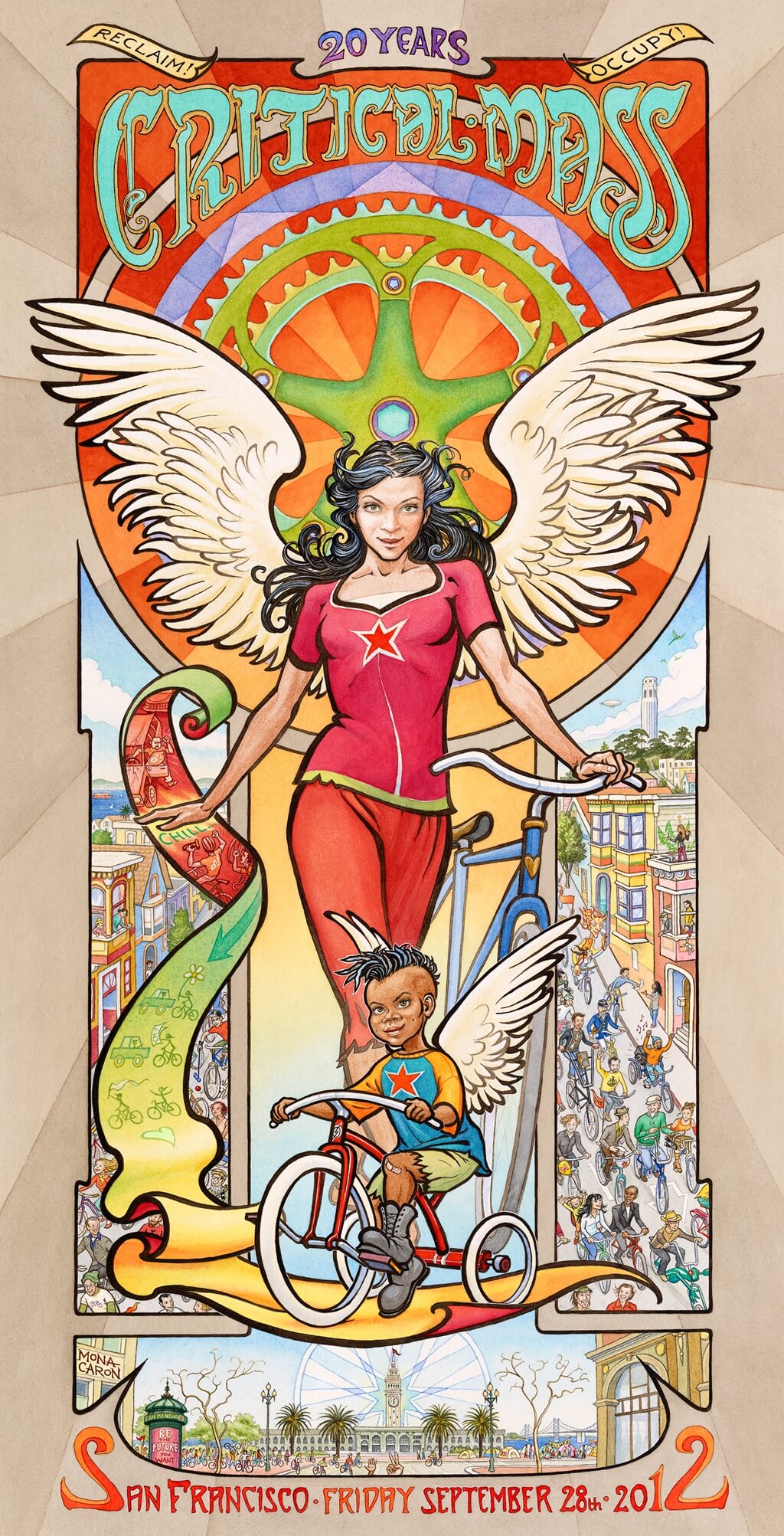Where There’s a Wheel, There’s a Way: Critical Mass Turns 30
By Kent Klaudt
Critical Mass celebrated its 30th anniversary in San Francisco on September 30, 2022, but the history of bicycle activism here dates to the 19th century. On July 25, 1896, more than five thousand cyclists from dozens of Bay Area bicycle clubs rode the streets of San Francisco in a parade-like protest ride demanding better street surfaces.

1896 Bike Parade art from the San Francisco Call
The San Francisco Call reported that: “Amid red fire, bombs, rockets and music, the cyclers of San Francisco had their display last evening in favor of good roads. There was a good number of those who love to ride on pneumatic tires, and the Parade was witnessed by thousands, who lined the streets through which the procession passed.” Among the cyclists were several wheeled-float contraptions, one of which carried a coffin bearing the words, “Killed by riding a wheel over the Market Street pavement.”
The Chronicle reported that the “teamsters and livery men have contributed aids to show their entire sympathy with the object of the demonstration. A great many of the clubs will carry their wheels three blocks down Market Street to show that the pavement is too bad for a self-respecting wheel to be sent over. Every cyclery in the city will be closed to-night, and the cyclists say that if the Supervisors do not take notice of this demonstration it will be because they have no eyes and do not know who does the voting.”
“After a long struggle with the park commission, San Francisco bicycle clubs won greater access to Golden Gate Park’s excellent roads in the early 1890s. Every weekend, packs of cyclists rode through the park to Ocean Beach, where a section of the Great Highway had recently been graded and paved. One Sunday in 1896, an Examiner reporter stationed himself on a park path to count the cyclists that passed between 7 a.m. and 5 p.m. He tallied almost 3,000.”[1]
Nearly 100 years later, San Francisco saw another pack of cyclists converge at the foot of the Embarcadero in September 1992, attending the first of a quasi-leaderless event that became known as Critical Mass — a party, protest, and celebration of bikes and bike culture all rolled into one mass of cyclists roaming the city on the last Friday of every month for the past 30 years. That first event in 1992 had a very basic and immediate agenda: gathering bicyclists to ride home as a group in the evening commute for their own safety in a motorist-dominated city with very few bike lanes.
 San Francisco Critical Mass, April 29, 2005. Photo: Michael W. Parenteau, courtesy of Wikimedia Commons.
San Francisco Critical Mass, April 29, 2005. Photo: Michael W. Parenteau, courtesy of Wikimedia Commons.
In the pre-internet days of 1992, Critical Mass organizers distributed photocopied flyers publicizing the ride. By early 1993, several hundred people were showing up each month, and 1,000 cyclists participated in the first anniversary ride. Critical Mass’s attendance numbers have waxed and waned throughout the past three decades, and even survived an attempted crackdown by SFPD in 1997 under then-mayor Willie Brown — a crackdown which backfired and only caused more bicyclists to join the monthly rides.
Critical Mass never had an explicit political manifesto, but interviews over the years with longtime key participants make it clear that improving awareness of and respect for bicyclists’ safety and rights in San Francisco were and are a key component of the event.
 Critical Mass 20th Anniversary art by Mona Caron.
Critical Mass 20th Anniversary art by Mona Caron.
Thirty years after that first ride, San Francisco now has an extensive 448-mile bike network comprised of sharrows, striped unprotected bike lanes, off-street bike paths, and protected bike lanes. Only 19 of these 448 miles are protected bike lanes, however, so there is still more work to be done in making this a bike-friendly city. We now have members of the Board of Supervisors who are cyclists and bicycle rights advocates, and a more firmly established bicycle culture generally. Looking back, it seems clear that Critical Mass played a huge role in raising consciousness among the public and politicians on a wide range of bicycle-related issues. Indeed, one early Critical Mass activist, Chris Carlsson, observes that the “bike infrastructure we have today would not exist without Critical Mass — mass seizure of the streets.”
[1] LaBounty, Woody, Bicycles West, Ocean Beach Bulletin, Dec. 2016, reprinted by permission of the author.
Inside this issue
Have you or someone you know been involved in a bicycle crash? Want to know about your rights? Are you a lawyer handling a bicycle crash who wants the best result for your client? Contact Bicycle Law at (866) 835-6529 or info@bicyclelaw.com.
Bicycle Law’s lawyers practice law through Coopers LLP, which has lawyers licensed in California, Oregon, and Washington state, and can affiliate with local counsel on bicycle cases across the country to make sure cyclists benefit from cycling-focused lawyers.
